
views
Receiving Medical Treatment

Take prescribed antibiotics for bacterial infections. Most salivary gland infections caused by one or more blocked salivary ducts — a condition known as sialadenitis — can be bacterial in nature. This means that your doctor will typically prescribe an antibiotic as the first-line treatment. If so, take the antibiotic as directed and for as long as directed — even if you start feeling better. Common antibiotics for salivary gland infections include dicloxacillin, clindamycin, and vancomycin. Side effects can include diarrhea, nausea, indigestion, and abdominal pain. Some people develop mild allergy symptoms like itchy skin or coughing. If you develop severe abdominal pain or recurrent vomiting, or a serious allergic reaction like trouble breathing, get medical help right away.

Use an antibacterial rinse if directed by your doctor. In addition to an oral antibiotic, your doctor may also prescribe a mouth rinse that will help kill the bacteria in your salivary gland(s). If so, use the antibacterial rinse as directed. For instance, chlorhexidine 0.12% mouth rinse is often prescribed for use 3 times per day. You’ll simply swish it around in your mouth for the directed amount of time, then spit it out.
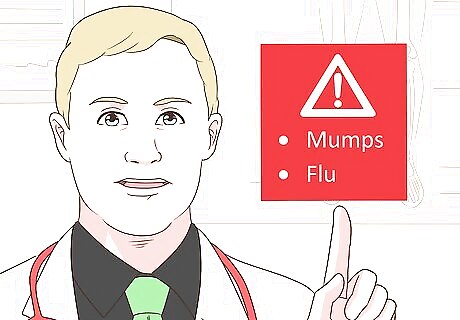
Treat the underlying cause of a viral salivary gland infection. If your infection is diagnosed as viral in nature, antibiotics will not treat it. Instead, your doctor will focus on addressing the underlying cause of the infection — such as the mumps or the flu — and providing symptom management for the salivary gland infection. In addition to influenza and mumps, viral conditions like HIV and herpes can cause salivary gland infections. So too can medical conditions like Sjogren’s syndrome (an autoimmune disease), sarcoidosis, and radiation therapy for oral cancer.
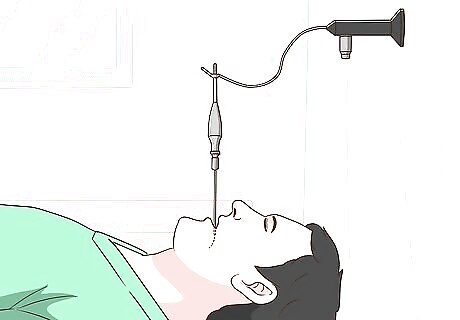
Ask about sialendoscopy to treat a blockage. This is a relatively new treatment that involves the use of a tiny camera and tools to both diagnose and treat salivary gland infections. With sialendoscopy, blockages and infected areas can sometimes be removed to help speed the recovery process. Sialendoscopy is an outpatient procedure with a high rate of success, but it may not be available in all areas due to its more recent introduction and the training required for the doctors who perform it.
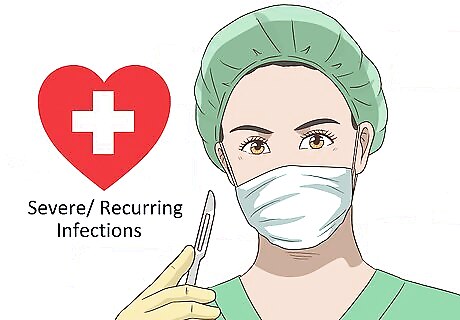
Consider surgery for severe or recurring infections. If a salivary gland duct blockage is chronic or causing significant complications, the best course of action may be to remove the gland via surgery. You have 3 pairs of major salivary glands — near the back of your jaw, and under the front and back of your tongue — so the removal of one will not significantly impact your saliva production. This type of surgery only takes about 30 minutes, but does require general anesthesia and an overnight hospital stay. Full recovery takes around a week, and the risk of complications is minimal.
Supplementing Your Medical Care at Home

Drink 8-10 glasses of water with lemon per day. Keeping your body well hydrated makes it easier to produce saliva, which in turn can help to clear the infection and blockage. Additionally, sour foods spur the production of saliva, so dropping a lemon wedge or two into your water glass is doubly effective. Plain water with lemon is the best choice, as opposed to sugary beverages like lemonade, which are bad for your dental and overall health.

Suck on lemon candies or lemon wedges. Sour candies cause your saliva production to increase, but stick to sugar-free versions in order to protect your teeth. For a more natural — and sour! — fix, cut a lemon into wedges and suck on them one at a time throughout the day.
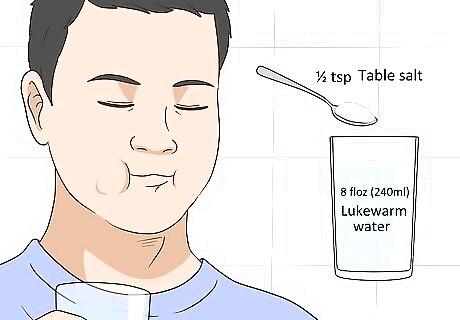
Rinse your mouth with salted, tepid water. Add half a teaspoon of table salt to 8 fluid ounces (240 ml) of lukewarm water. Take sips of the water, swish them around in your mouth for several seconds each, and spit them out. Don’t swallow the water. Do this roughly 3 times per day, or as often as your doctor advises. Salted water helps to clear away the infection and can provide some temporary pain relief.
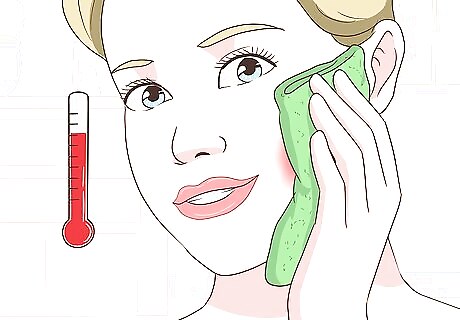
Apply warm compresses to your cheek or jaw. Soak a cloth in warm — but not uncomfortably hot — water, then hold it against your skin outside the spot where the infected gland is located. Hold it there until the cloth cools. You can typically repeat this as often as desired, unless otherwise instructed by your doctor. Warm compresses can help reduce swelling and provide some temporary pain relief. Salivary gland infections most commonly occur in the glands in the back of your mouth, so you’ll typically be holding the compress just beneath your ear.

Massage your cheek or jaw with your fingers. Applying gentle pressure, move your first two fingers in a circular motion on the skin outside the infected gland — for example, right beneath one of your ears. Do this as often as you like, or as directed by your doctor. Massaging the area can help relieve pain and swelling, and may aid in clearing away the salivary duct blockage.
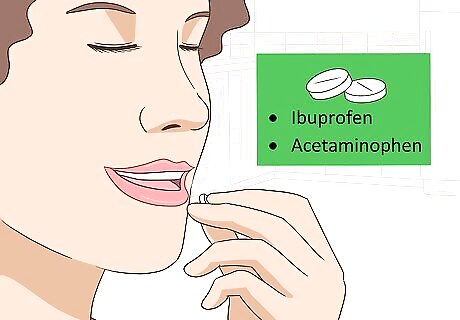
Take over-the-counter pain relievers as advised by your doctor. Ibuprofen or acetaminophen can help relieve the pain associated with a salivary gland infection, and reduce the fever you might develop due to the infection. Even though these are OTC medications found in practically every medicine cabinet, it’s best to consult your doctor before taking one for a salivary gland infection. Take the medication as directed on the packaging and/or by your doctor.
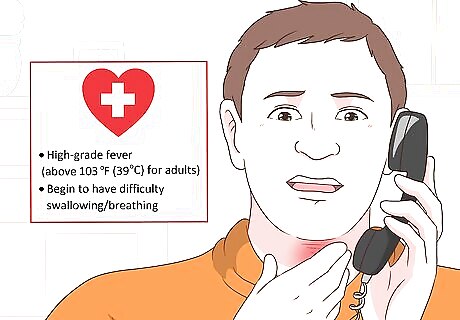
Contact your doctor again if your condition worsens. Major complications are rare with salivary gland infections, but they can occur. If you develop a high-grade fever (above 103 °F (39 °C) for adults), or begin to have difficulty swallowing or breathing, seek emergency medical care. If you're having trouble breathing, this is a life-threatening condition. These symptoms can indicate that the infection has spread.
Lowering Your Chances of a Salivary Gland Infection
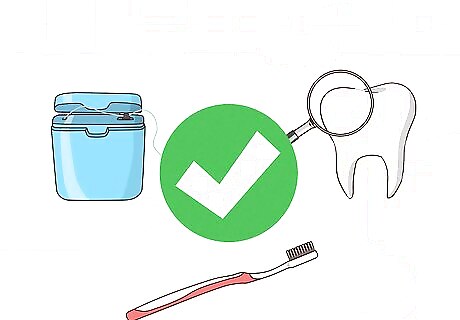
Practice good oral hygiene. There is no way to completely prevent salivary gland infections, but reducing the bacteria in your mouth through proper dental care appears to help quite a bit. Brush your teeth at least twice a day, floss regularly, and get dental checkups once or twice a year.

Drink lots of water every day. The more water you drink, the more saliva you’ll be able to produce. This makes a salivary duct blockage — and therefore an infection — less likely. Plain water is your best choice for hydration. Sugary beverages are bad for your teeth and overall health, and caffeine and alcohol can actually work to dehydrate you.
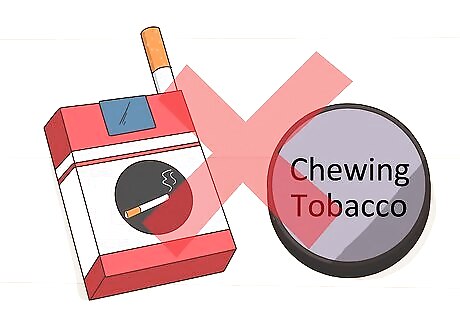
Don’t smoke or chew tobacco. Think of this as one of the countless reasons why you should quit smoking, chewing tobacco, or never start in the first place. Using tobacco introduces bacteria and toxins into your mouth that may help cause salivary gland infections. Using tobacco can also increase your risk of developing cancer in one or more of your salivary glands. In addition to salivary gland infections, chewing tobacco can cause salivary gland cancer. Talk to your doctor if you feel a lump near your jaw, below your ear, or on the lower part of your cheek. If you're in the US, you can call the CDC's quit line at 1-800-QUIT-NOW for support.
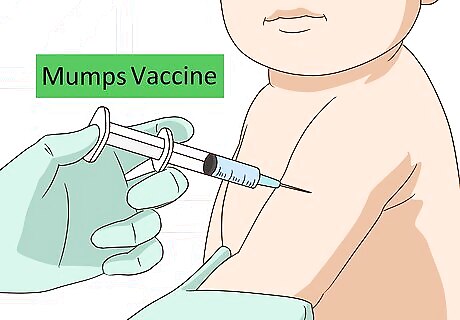
Get vaccinated for the mumps. The mumps used to be one of the most likely causes for viral salivary gland infections. However, the widespread use of the MMR (measles, mumps, and rubella) vaccine has reduced this significantly. In the U.S., children usually receive the MMR vaccine at 12-15 months of age, and again at age 4-6. If you weren’t vaccinated as a child, talk to your doctor about it right away.
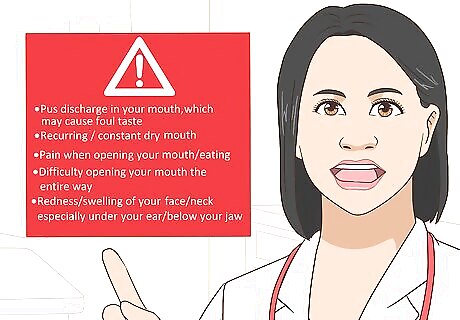
Visit your doctor if you have potential symptoms. A salivary gland infection can cause common infection symptoms like a fever and chills. In addition, though, you might also experience: pus discharge in your mouth, which may cause a foul taste recurring or constant dry mouth pain when opening your mouth or eating difficulty opening your mouth the entire way redness or swelling of your face or neck, especially under your ear or below your jaw
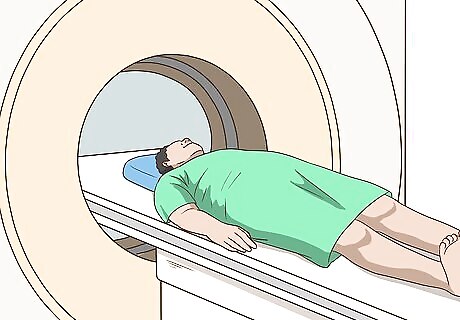
Undergo tests to check for a salivary gland infection. In many cases, your doctor can diagnose this condition with a simple visual examination and analysis of your symptoms. In some instances, though, they may want to use an ultrasound, MRI, or CT scan to more closely study the area before making a diagnosis. If there is a concern that you may have a tumor blocking the salivary duct, your doctor might recommend a needle biopsy to get a sample of the tissue.




















Comments
0 comment